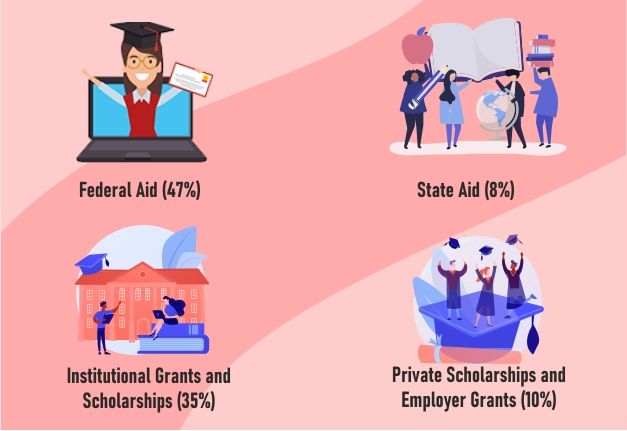A university scholarship will only help you out more because in the world of higher education, sometimes a little extra goes a long way. When applying to universities, many students consider scholarships, and all of them will provide financial aid to their students if they need it.
A convenient way to pay for an undergraduate degree is through college and university scholarships, but many students are unsure of how the entire application process works. We’ll talk about scholarships in this article. Please keep reading.
What Is A Scholarship?
Scholarships are financial aid awards given by colleges and universities to students to assist them in covering the cost of an undergraduate degree. A scholarship may occasionally come in the form of a lump sum payment. Other scholarships for higher education offer money to students every semester or academic year and are renewable. These awards are distinct from student loans in that they don’t require repayment.
Students may get a check in their name for the money directly. In other situations, the student’s school receives the funding. The difference in any tuition, fee, and room and board payments would then be made by the student to the school in these circumstances. The remaining funds are returned to the student if scholarships and other financial aid are sufficient to pay for direct college expenses.
Who Can Quality For Scholarships?
Not all students who have a 4.0 GPA are given scholarships. Each scholarship has specific requirements. On the basis of need, some scholarships are given out. Others have requirements that you must meet, such as belonging to a particular organization, studying a particular subject, or meeting the criteria established by the organization giving out the funding.
You should be able to find a number of scholarships that work for you, regardless of whether you have strong academic credentials. Even students who reside in a particular town or state may be eligible for scholarships. Throughout your undergraduate years and up until your Ph.D., you are still eligible to apply for scholarships. studies.
What Are The Main Sources Of Scholarships And Grants?
The four main categories of free money available to college applicants are as follows. Here are the four main sources of scholarships and grants, and the percentage of total grants and/or scholarships that comes from each source:
- Federal grants: 47%
- State grants and scholarships: 8%
- Scholarships and grants from schools: 35%
- Private scholarships: 10%

Knowing where to look for assistance and what grants and/or scholarships you might be eligible for is crucial when looking for money. Here is a breakdown of what each type of assistance offers:
Federal Aid (47%)
You will not be successful in your search for merit scholarships from the federal government. The federal government requires proof of the financial need for almost all grants. To qualify for any federal grants, you must complete the Free Application for Federal Student Aid (FAFSA). Here are the top two federal aid grants.
Pell Grant
The largest federal grant by far is the Pell Grant. The full grant is currently $5,920 and is adjusted yearly. Most students who are eligible for the full amount have household incomes of less than $60,000. A partial grant may be eligible for recipients.
Federal Supplemental Educational Opportunity Grant
The FSEOG is available for students who have “exceptional financial needs.” You will not be eligible for this grant, which has an annual range of $1,000 to $4,000 if you are not eligible for a Pell Grant. The FSEOG won’t be offered on every campus, and funding might run out.
Education Tax Benefits
You can claim a number of education tax benefits from the federal government on your federal income tax return. Some are based on the price of books and tuition. These include the Tuition & Fees Deduction, the Lifetime Learning Tax Credit, and the American Opportunity Tax Credit (AOTC).
The AOTC, which can only be used for four years, offers the greatest tax savings per dollar of eligible higher education costs. After their eligibility for the AOTC has been exhausted, graduate and professional students as well as students in continuing education primarily use the LLTC.
The Student Loan Interest Deduction, which offers an above-the-line exclusion from income for up to $2,500 in interest paid on federal and private student loans, is another well-known tax break for education.
Veterans And Military Student Aid
Members of the US military can receive a variety of forms of federal financial aid. military personnel and veterans. Examples of these include the Montgomery G.I. Bill, the G.I. from after 9/11 Bill, the American Yellow Ribbon Program Armed Forces Tuition Assistance (TA), and the Student Loan Repayment Program.
Federal Loans
Federal loans are an option if you’re not qualified for grants from the government.
- For those who submit a FAFSA and are enrolled at least half-time in school, the Direct Loan is available. Students may borrow up to $31,000 over a five-year period.
- Parents of undergraduate students as well as graduate and professional students are eligible for the PLUS Loan. The price of the school minus the amount of financial aid the child received can be borrowed by the parents.
State Aid (8%)
There is usually at least one grant or scholarship program accessible to residents of the state through each state education agency. Some offer a variety of programs.
States in the South are more likely to give grants based on test results and perhaps grade point averages. States on the East and West coasts are more likely to offer awards based on financial need.
Visit the website of the National Association of Student Financial Aid Administrators (NASFAA) to find out more about the assistance programs available in your state.
On the NASFAA website, you can find links to your state aid programs by following these steps:
- Click on the Students, Parents & Counselors link
- Then click on Financial Aid in Your State link
- Next, choose the State Financial Aid Programs link
- Once you dial the U.S. map, click on your state

Some state programs, like those in California and New York, have centralized systems, which means that awards are determined by state-level formulas. In other states, the government establishes fundamental standards but leaves some discretion to public universities in deciding who gets the awards. Texas and Virginia fall into this category of states.
Institutional Grants And Scholarships (35%)
Here is how the awarding procedure typically operates. A school’s admissions office chooses whether to accept an applicant after the student submits an application. If the school offers merit scholarships, the choice will usually be made during the admissions process and will typically be based on the applicant’s academic performance and test results.
This frequently occurs before the school is aware of a teen’s eligibility for need-based financial aid. After reviewing the financial aid application and taking into account merit scholarships, the admissions staff determines whether a child still requires assistance.
In addition to the scholarship, the school may also award a need-based grant if it wants to help the student further. Research universities and liberal arts colleges with the highest rankings do not offer merit-based scholarships.
They only provide need-based grants as their only form of assistance. In light of this, you will be required to pay full price at these institutions if you are not eligible for need-based financial aid. It’s crucial to use a net price calculator when assessing the generosity of any school because of the wide range of assistance that you may receive.
Private Scholarships And Employer Grants (10%)
Private scholarships are awarded by outside organizations such as foundations, civic associations, businesses, organizations of believers, professional associations, and charities. Private scholarships are among the smallest sources of funding for education, despite the common misconception that they are the largest.
Unlike other sources, these scholarships typically have a one-year duration, and the majority of awards are less than $4,000 each. You have a one in eight chance of winning a scholarship. Chances of receiving prestigious scholarships can range from one in 250 to one in 500.
How Do Scholarships Operate?
The term “scholarship” refers to financial aid given to a student on a specific basis, typically academic merit. They may be determined by a number of eligibility factors, including needs, origin country or region, gender, subject of study, race, etc. Since a scholarship is not a loan, it is not required to be repaid.
Grants, tuition waivers, and fellowships are some of the ways they are offered. The best way to help students complete their education—typically higher education—is through scholarships.
They are given out to relieve current and former students, as well as their families, of a sizable portion of the significant financial obligations associated with higher education. For undergraduate and graduate study in colleges, universities, and other educational institutions, various organizations and bodies grant scholarships.
Scholarships can cover a range of expenses typically associated with higher education, including transportation costs, lab fees, books, room and board, and tuition. Sometimes a scholarship is a one-time payment.
Other scholarships are renewable, giving recipients money each academic year or semester for a few years or their entire course of study. Scholarships may be fully or partially funded, which means that they may pay the entire cost or only a portion of it.
In some instances, the student is given the scholarship funds directly and they are made in their name. On other occasions, the funds are given to the student’s institution or school. If there is a discrepancy in the amount owed to the institution for tuition, room, and board, or other fees, the student is then responsible for making up the difference.
If the scholarships are sufficient to cover the direct costs of higher education, the student is given back the excess money.
Scholarship awards typically include a number of details, such as the rules and the obligations of the recipients. Depending on the scholarship provider’s specific requirements/rules, a scholarship may be terminated for any number of reasons.
For instance, if a student’s grades declined, he or she engaged in illegal activity or misused the scholarship’s funds, the scholarship provider may stop funding it.

Which Scholarships Can I Apply For?
The different types of scholarships available:
- Academic excellence scholarships: many universities offer scholarships to students who achieve specified grades in their A Levels to influence students with higher academic achievement to select their university. Some of them are offering money for ABB or less, so they are not all demanding A*AA.
- Musical scholarships: You may be given a musical scholarship if you have good vocal or instrumental skills and are willing to perform while attending the university. You don’t have to be a music student to qualify.
- Personal circumstances: Scholarships are based on your individual circumstances, such as where you’re from, whether you’ve left the foster system, what your parents do for a living, or your religion. These could originate from neighborhood authorities, religious institutions, or nonprofit organizations.
- Financial need: These are the more common scholarships that give money to deserving candidates who might not otherwise be able to attend college. These are frequently referred to as grants or bursaries, and receiving one may require you to provide documentation of your financial situation.
- Sporting achievement: Many universities will offer scholarships if you have achieved outstandingly in sports in an effort to draw in the top students. Of course, you’ll have to play for the school in your sport.
- Company scholarships: More businesses are starting to offer scholarships, and some of these offers come with work experience. Industry associations also use scholarships to entice young talent to enter their field. Particular demand exists for female engineering students.
- Your interests and hobbies: there are some scholarships that are based on your extra-curricular activities such as showing a commitment to social engagement or improving the lives of others.
- Other scholarships: increasingly there are more scholarships being offered by companies, where all students have to do is submit an essay or video. Many come from the United States, where scholarships are offered much more frequently, and these American businesses are now making their scholarships available to students in the United Kingdom. Others come from UK-based businesses that are beginning to see the benefits of this program.
What Makes A Scholarship Valuable?
Everywhere in the world, higher education is quite expensive, despite the fact that it significantly improves your chances of having a better life. Scholarships offer a fantastic way to bridge the financial gap between your higher education budget and rising tuition costs. You must be eligible for one of the scholarships that are available.
You can lessen your stress while pursuing your higher education goals by using a scholarship, which makes it crucial. The majority of families might not be able to afford to send their kids to college, but anyone who qualifies for a scholarship can pursue higher education.
Other opportunities may become available as a result of a scholarship. Lifelong ties to a person, group, institution, organization, or nation can be formed as a result.
Many scholarship recipients have established long-lasting, mutually beneficial relationships with the organizations that provided their scholarships, including universities, non-governmental organizations, corporations, foundations, governments, and other countries.
If it weren’t for a scholarship, these connections might not have developed. Therefore, whether it’s Royal Imperial College or UC Berkeley, MasterCard or the United Nations, the USA or the UK, a scholarship might just be the key to establishing a rewarding relationship with the college, organization, or nation you have in mind.
